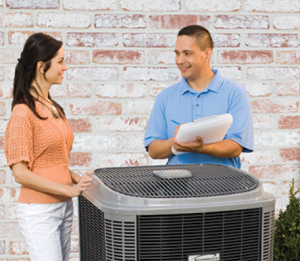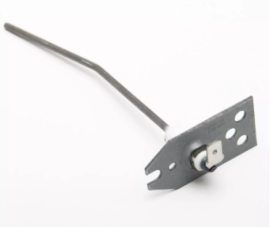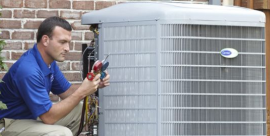2023 HVAC regulation changes and how they may affect you


New government guidelines are about to take effect on January 1, 2023. These U. S. Department of Energy (DOE) regulations bump up the energy efficiency standards for central air conditioners and heat pumps.
These new standards continue DOE initiatives to reduce energy consumption of the home systems that typically use the most electricity in your home. The new regulations can create these short-term challenges in 2023:
Availability of replacement parts for HVAC systems may become scarce in 2023 as homeowners maintain and repair their older heating and cooling systems.
Prices of new HVAC systems will rise as a result of manufacturers having to produce heating and cooling systems that meet the new DOE standards.
Supply of new central air conditioners and heat pumps will be limited in early 2023.
Knowing about the new DOE regulations for heating and cooling systems and how they can affect you will help you take steps to keep your family safe and comfortable in 2023.
What are the new DOE HVAC regulations for 2023?
Beginning January 1, 2023, air conditioners and heat pumps will need to meet these new minimum seasonal energy efficiency ratio (SEER) ratings:
14 SEER for systems used in northern states (2022 requirement was 13)
15 SEER for systems used in southern states (2022 requirement was 14)
What are SEER ratings?
SEER is the ratio of the total heat removed from the conditioned space during the annual cooling season divided by the total electrical energy consumed by the air conditioner during the same season. So, the higher the SEER rating, the less electrical energy your air conditioner uses to cool your home. That’s good news.
What are SEER2 ratings?
You may also hear about SEER2 ratings beginning in 2023. SEER2 is basically the same as the seasonal efficiency ratio (SEER) described above but SEER2 is measured differently. The SEER2 rating measures the energy efficiency ratio under test conditions that more accurately approximate real world scenarios of installed AC units. SEER2 ratings often differ from SEER ratings by about .5 SEER.
Starting January 1, 2023, HVAC efficiency standards will be expressed in SEER2 ratings instead of SEER.
The incremental increases in efficiency standards for central air conditioners and heat pumps seem small but their significance in collectively reducing carbon emissions in 2023 and beyond will be massive.
What should I do?
First, schedule AC system check-up and maintenance service by Sears Home Services before the end of the year. That way you’ll know if your heating and cooling system shows signs of current or potential problems.
During HVAC maintenance service, our Sears Technician will check the entire system and test its operation. The tech will discuss any potential system problems with you after completing the maintenance service and checkup, as well as what next steps to take.
What to do if your HVAC system is in good shape
If your heating and cooling system is in good shape, the maintenance service will keep it working efficiently and help you avoid any unexpected repairs or replacement needs in 2023. You’ll have the peace of mind that you’ve done everything you can to keep your family comfortable and safe in the coming year.
Continue scheduling professional HVAC maintenance yearly to keep your central AC in top shape and avoid potential problems.
What to do if your HVAC system needs repair or replacement
If your air conditioner or heat pump has worn parts and needs repair, you’ll need to replace parts immediately to avoid HVAC parts shortages that may occur in 2023.
If your entire air conditioner or heat pump is worn down, the technician will discuss repair and replacement options with you during the maintenance service. You’ll need to schedule a free consultation with a Sears Homer Service heating and cooling expert immediately to arrange HVAC replacement and get the best price and installation timelines for your new system.
Replacing a worn HVAC system before 2023 will help you avoid potential problems caused by new DOE energy efficiency regulations going into effect for heating and cooling systems.
Frequently asked questions about 2023 DOE HVAC regulations
Understanding key aspects of current and new DOE HVAC regulations can help you make sound decisions about your heating and cooling system. These frequently asked questions provide details about DOE standards for air conditioners and heat pumps.
Why is the SEER Rating of my HVAC system so important?
Installing a heating and cooling system with a high SEER rating helps reduce carbon emissions and has a positive effect on our environment. Additionally, installing a high-SEER AC unit will save you money through lower electric bills. Over the life of a typical AC unit, the DOE estimates that you’ll see about $320 of savings after replacing an older, less efficient HVAC system.
Why did the DOE enact new HVAC efficiency standards for 2023?
The DOE first implemented energy conservation standards for central air conditioners in 1992 and last updated the standards in 2015. The estimated number of carbon dioxide emissions that will be avoided as a result of the 2015 HVAC standards is 50 million metric tons. Because of the positive effect on the environment and the successful implementation of the 2015 standards, the 2023 update implements slightly higher efficiency levels and the uses the new SEER2 metric that better measures real-world HVAC installation and use. The intended impact of the new 2023 standards will be to continue to lower CO2 emissions to help our environment.
Why are SEER standards higher for southern states?
Central air conditioner use varies widely between northern and southern states of the country because of significant outside temperature differences. Setting slightly higher efficiency standards for air conditioners in southern states (where cooling is needed more frequently) increases the environmental impact of HVAC regulations.
How are the Northern and Southern Regions determined by the DOE?
The DOE uses the population-weighted number of heating degree days (HDD) to establish the dividing line between northern and southern states. An HDD is counted when average daily temperature is below 65 degrees (indicating that your home needs heating). HDD’s in a state are then weighted based on population.
States with 5,000 HDD or more are considered part of the northern region, while states with less than 5,000 HDD are considered part of the southern region. Homes in southern states use the air conditioner much more often because they have less HDD’s.
Which states are in the Northern and Southern Zones?
Northern region states include: Alaska, Colorado, Connecticut, Idaho, Illinois, Indiana, Kansas, Massachusetts, Maine, Michigan, Minnesota, Missouri, Montana, North Dakota, Nebraska, New Hampshire, New Jersey, New York, Ohio, Oregon, Pennsylvania, Rhode Island, South Dakota, Utah, Vermont, Washington, West Virginia, Wisconsin, and Wyoming.
Southern region states include: Alabama, Arizona, Arkansas, California, Delaware, Florida, Georgia, Hawaii, Kentucky, Louisiana, Maryland, Mississippi, Nevada, New Mexico, North Carolina, Oklahoma, Puerto Rico, South Carolina, Tennessee, Texas and Virginia.
For more information about the new 2023 HVAC regulations, see the DOE 2023 Central Air Conditioner Answers to Frequently Asked Questions. That document has additional details and references to source documents for 2023 DOE regulations.
Most common symptoms to help you fix your heating & cooling combined units
Choose a symptom to see related heating and air conditioning system repairs.
Thermostat problem, clogged air filter, burner failure…
Dirty air filter, clogged condenser coils, low refrigerant charge, faulty compressor…
Thermostat problems, bad compressor/condenser fan capacitor, lack of refrigerant, failed compressor…
Main causes: errant thermostat settings, lack of electrical power, clogged drain line, wiring failure, control failure.…
Main causes: Errant thermostat settings, lack of power, bad interlock switches, lack of exhaust ventilation, wiring fail…
Dirty flame sensor, failed flame sensor, damaged burner, bad high limit switch…
Most common repair guides to help fix your heating & cooling combined units
These step-by-step repair guides will help you safely fix what’s broken on your HVAC system.

How to unclog the air conditioner drain line
The condensate drain line for your central air conditioner can clog with mold and mildew. Water will back up and start d…

How to replace the furnace flame sensor
The flame sensor detects when furnace burner flames are lit. You may need to replace the flame sensor if flames only sta…

How to replace a heating and air conditioning system thermostat
The control thermostat for your HVAC system can stop working. This repair guide shows how to replace it.…
Effective articles & videos to help repair your heating & cooling combined units
Use the advice and tips in these articles and videos to get the most out of your HVAC system.

Learn how to maintain your central air conditioner to keep it running smoothly all summer long.…

Learn about all the convenient features on our Sears PartsDirect website that make your parts purchases easier.…

Get answers to frequently asked questions about Sears and Sears PartsDirect.…